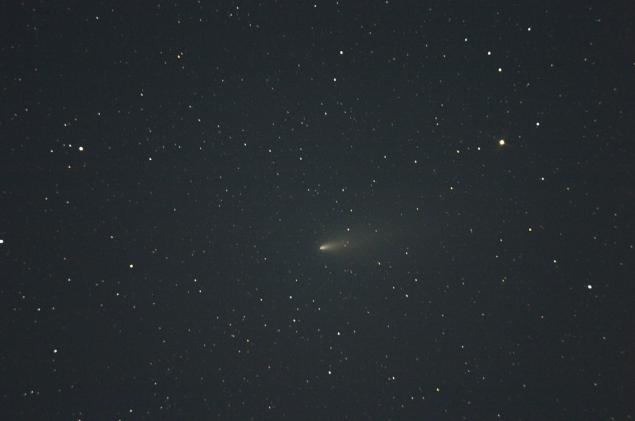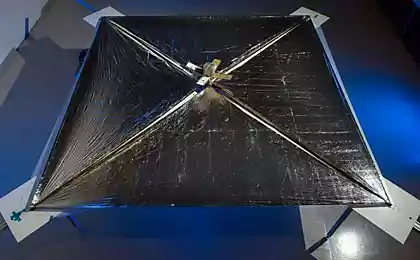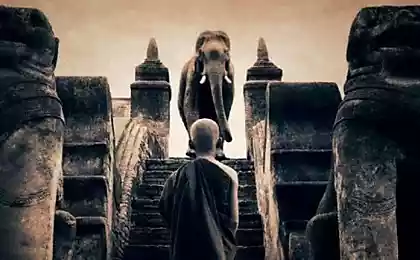2280
IT people on vacation, a little practice the amateur astrophotography
Seeing the previous post «pros holiday: gadgets to the telescope» , decided to develop a theme a little astrophotography using a telescope and DSLR cameras. I am an absolute fan of this matter, but I think my modest experience can be fun.
The beginning of the path h5> His interest in astronomy, I revived somewhere 9-10 years ago, when the stores began to appear from the available telescopes Synta and Celestron. First telescope for me was the Synta Skywatcher 70/900 refractor on equatorial mount EQ2 with the motor in right ascension. Poglazev a night at the Moscow sky from the window of the apartment and had absolutely childish delight when observing Jupiter and its satellites, it was decided to capture it all. The idea to shoot on a bar of soap, attaching it to the eyepiece, I have not liked, and I moved in the direction of the shooting at the prime focus of the telescope - that is, when the camera is mounted in place of the eyepiece. Options cameras for less quality planetary shooting at that time was a little - Meade LPI, Celestron NexImage webcam and Philips. The cost of the camera Meade was significantly higher than the last two, and in the end, I took the camera from Celestron. Unlike Phillips it was not necessary to remodel for mounting on a standard knot amateur telescope eyepiece (1.25 ").
The main gauge h5> Based on the characteristics (diameter primary mirror and a 200mm focal length 1000mm), the main thrust of C8-N - deep-sky objects (so-called "deep sky"). On Cam, no way, in fact, is the Celestron NexImage, deep sky shoot difficult. There are already required long exposures and a large matrix. At that time in my possession already was the first affordable digital SLR camera Canon EOS 300D. It remained the case for small - to buy an adapter ring to mount on the Canon EOS T thread. Barlow lens with a T-adapter was purchased directly from the telescope (lens itself can be unscrewed). The process of shooting looked like - was subject, was shot eyepiece and in its place was inserted in camera. Focusing made through the camera viewfinder, the shutter with the remote, shutter controlled manually (bulb mode). Thus, I was able to shoot images with exposure to 1 minute. On a long exposure picture of the port is not perfect keeping the subject mount, not always well-exposed polar axis of the mount and the maximum weight of all the equipment for this mount.
Example shooting direct focus: h6>
Examples shooting Meade LPI at the prime focus: h6>
Example shooting galaxy M51 "Whirlpool»: h6>
PS h5> There are other ways to make subjects "deep sky". For example shooting using specialized cameras such as SBIG, FLI, etc. with the filter wheel and the shooting time of one object to several nights. But, in my opinion, this is no longer an amateur and professional photography. Yes, and for realizing the potential of such cameras need completely different equipment, not comparable in price and quality with affordable amateur telescopes.
The beginning of the path h5> His interest in astronomy, I revived somewhere 9-10 years ago, when the stores began to appear from the available telescopes Synta and Celestron. First telescope for me was the Synta Skywatcher 70/900 refractor on equatorial mount EQ2 with the motor in right ascension. Poglazev a night at the Moscow sky from the window of the apartment and had absolutely childish delight when observing Jupiter and its satellites, it was decided to capture it all. The idea to shoot on a bar of soap, attaching it to the eyepiece, I have not liked, and I moved in the direction of the shooting at the prime focus of the telescope - that is, when the camera is mounted in place of the eyepiece. Options cameras for less quality planetary shooting at that time was a little - Meade LPI, Celestron NexImage webcam and Philips. The cost of the camera Meade was significantly higher than the last two, and in the end, I took the camera from Celestron. Unlike Phillips it was not necessary to remodel for mounting on a standard knot amateur telescope eyepiece (1.25 ").
The process of planetary shooting fairly simple - record videos, which are then processed in the program Registax.
Further developments have been the standard for the novice amateur astronomy - telescope wanted more. As a result, the DR I gave myself 8 "(200mm) reflector Newton Celestron C8-N on equatorial mount CG-5 with motors on both axes.
The main gauge h5> Based on the characteristics (diameter primary mirror and a 200mm focal length 1000mm), the main thrust of C8-N - deep-sky objects (so-called "deep sky"). On Cam, no way, in fact, is the Celestron NexImage, deep sky shoot difficult. There are already required long exposures and a large matrix. At that time in my possession already was the first affordable digital SLR camera Canon EOS 300D. It remained the case for small - to buy an adapter ring to mount on the Canon EOS T thread. Barlow lens with a T-adapter was purchased directly from the telescope (lens itself can be unscrewed). The process of shooting looked like - was subject, was shot eyepiece and in its place was inserted in camera. Focusing made through the camera viewfinder, the shutter with the remote, shutter controlled manually (bulb mode). Thus, I was able to shoot images with exposure to 1 minute. On a long exposure picture of the port is not perfect keeping the subject mount, not always well-exposed polar axis of the mount and the maximum weight of all the equipment for this mount.
Example shooting direct focus: h6> 
Comet Schwassmann-Wachmann 73P component B. Shooting 13.05.2006. A single frame. Canon EOS 300D in prime focus of the telescope Celestron C8-N. ISO 400. Shutter speed 30 sec. Without guiding. I>

Star Cluster M13 in the constellation Hercules.
Taken with Canon EOS 300D + 2x Barlow at the prime focus of the telescope Celestron C8-N. A single frame. ISO 400, shutter speed - 58 seconds. Without guiding. I>
Also, on occasion, I have replaced the planetary camera on the Celestron NexImage Meade LPI. The camera on the Meade has one slight advantage over Celestron - bundled software Meade Autostar. The program on the fly folds obtained from the camera images and in real time, you can observe the quality of the final image.
Examples shooting Meade LPI at the prime focus: h6> 
Saturn.
Taken with Meade LPI + 2x Barlow at the prime focus of the telescope Celestron C8-N. Sum ~ 120 frames of ~ 800 i>

Jupiter.
Taken with Meade LPI + 2x Barlow at the prime focus of the telescope Celestron C8-N. The amount of ~ 200 frames of ~ 1000 i>
As is well known appetite comes with eating. It was decided to replace the mount on a sling and with a computer-guided - Synta EQ-6 SynScan. At the same time I bought a small telescope for guiding (refractor Deepsky 80/400), Gidirim black and white camera QHY-5 and made a platform for the installation of two telescopes on one mount. I think that from this point on is worth shooting paint process in more detail:
Guiding to compensate for most of the standard problems of mechanics and electronics mount. In the simplest case, for shooting with guiding device requires mount with the ability to connect to a computer, two telescopes and two cameras. On the main telescope mounted camera for shooting and parallel to the second set with a small telescope guide camera. Mount and Gidirim camera connected to the computer. After that suggests the subject, we find the telescope guide the brightest star in the field of view and configure in a special program (Guidemaster, PHDGuide etc.) tracking the star. As a result, the program will track the displacement of the star and send in the mount command, correcting inaccurate adjustments to the polar axis of the motor and mount. As a result, we are able to use very long exposures, up to a few hours.
Example shooting galaxy M51 "Whirlpool»: h6> 
Taken with a Canon EOS 30D at the prime focus of the telescope Celestron C8-N on the mount EQ-6 SynScan. A single frame. ISO 400, shutter speed - 508 sec. With guiding device. I>
To date, I stopped at the next set of photos:
Telescope Celestron C8-N, Mount Celestron CG-5 Advanced GT, Gidirim telescope DeepSky DT80 / 400
Camera guide QHY5, Lunar and Planetary Camera Meade LPI, camera Canon EOS 500D
PS h5> There are other ways to make subjects "deep sky". For example shooting using specialized cameras such as SBIG, FLI, etc. with the filter wheel and the shooting time of one object to several nights. But, in my opinion, this is no longer an amateur and professional photography. Yes, and for realizing the potential of such cameras need completely different equipment, not comparable in price and quality with affordable amateur telescopes.
And, in conclusion, I should note that, despite the efforts of our Chinese friends and the general development of technologies astrofoto is still very expensive hobby.
Source: habrahabr.ru/post/226943/
Summary of the Soviet space exploration, types of rockets and the most significant victories in this field. Part 2
Interplanetary probe Rosetta performed third key maneuver and photographed the comet Churyumov-Gerasimenko




























